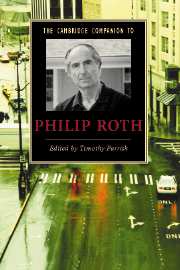Book contents
- Frontmatter
- Introduction: Roth at mid-career
- 1 American-Jewish identity in Roth’s short fiction
- 2 Roth, literary influence, and postmodernism
- 3 Zuckerman Bound: the celebrant of silence
- 4 Roth and the Holocaust
- 5 Roth and Israel
- 6 Roth’s doubles
- 7 Revisiting Roth’s psychoanalysts
- 8 Roth and gender
- 9 Roth and ethnic identity
- 10 Roth’s American Trilogy
- 11 Roth’s autobiographical writings
- Further reading
- Index
10 - Roth’s American Trilogy
Published online by Cambridge University Press: 28 May 2007
- Frontmatter
- Introduction: Roth at mid-career
- 1 American-Jewish identity in Roth’s short fiction
- 2 Roth, literary influence, and postmodernism
- 3 Zuckerman Bound: the celebrant of silence
- 4 Roth and the Holocaust
- 5 Roth and Israel
- 6 Roth’s doubles
- 7 Revisiting Roth’s psychoanalysts
- 8 Roth and gender
- 9 Roth and ethnic identity
- 10 Roth’s American Trilogy
- 11 Roth’s autobiographical writings
- Further reading
- Index
Summary
Judging from the fiction alone, Philip Roth experienced a spiritual meltdown during the second half of the 1990s. We'll leave it to the biographers to tell us why. And yet, paradoxically, he responded with a creative burst. From 1995 to 2001 he published five novels, each one more depressive than the last, and the first, Sabbath's Theater (1995), was an extended suicide note by its central character, Mickey Sabbath. It was followed in quick succession by American Pastoral (1997), I Married a Communist (1998), The Human Stain (2000), and The Dying Animal (2001). If we need an analogy to this collaboration of low spirits and high energy, this clamorous bleakness, we could turn to the blues, a music of great vitality whose lyrics commonly bemoan everything that is despairing in human existence. The only Roth novel of the past ten years (I write this in late 2005) to feel as if it came from something like personal equilibrium was The Plot Against America (2004), and that was about a Nazi takeover of America. This essay takes up the three central novels of this period, American Pastoral, I Married a Communist, and The Human Stain, those acid dissertations on the heart of American darkness that are commonly called the “American problem” novels and have been much celebrated for Roth's turn toward social issues with what appears to be a conservative agenda. Maybe so, though I tend to see these books as “Roth Problem Novels,” telling us more about the man than they do about the nation. This essay could well be titled “Blues in the Night,” but the title of a well-known Sigmund Freud essay seems to be more apposite: “Mourning and Melancholia.”
- Type
- Chapter
- Information
- The Cambridge Companion to Philip Roth , pp. 142 - 157Publisher: Cambridge University PressPrint publication year: 2007
- 2
- Cited by



